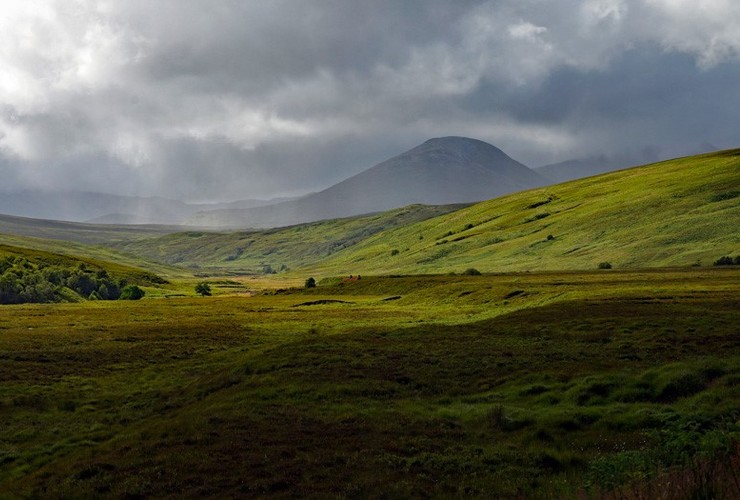Scotland's peatland policy update
As the Scottish Government's Peatland Advisory Group considers guidance on how to reduce the impacts of development on peatlands, our Senior Policy Officer Rosie Simpson reports on how and why this matters.

The hallmarks of wild are present in the UK’s peatlands, particularly where the peat is in a pristine condition, unmodified through land uses. Specialised plant life, vast ancient landscapes, hazardous terrain (as anyone who has been up to their knees in bog or climbed in, out and over peat hags will testify), golden eagles, big skies reflected in pools of water and the absence of manmade infrastructure are all qualities that help create the sense of awe, freedom and sanctuary which people often associate with being in wild places.
Unfortunately, most of the UK’s peatlands have been modified by humans. Peat cutting, grazing, draining, commercial extraction, are all activities that have altered the natural ecosystem of the peat bog. But our view is that the depleted condition of peatlands doesn’t mean they stop being wild or valuable. On the contrary, they present a crucial opportunity to restore nature and reduce carbon emissions from these large upland areas.
Wind farms on peatlands
In Scotland, peatlands are targeted for onshore wind farms because the exposed environment is well suited for wind energy production and there are few other economic uses for the land which rival the economic returns of renewable energy generation. This is borne out by the numbers: 218 out of the 456 wind farms that have already been built in Scotland are on peat. Of a further future 73 sites, 61% are peatland.
There is, however, a growing awareness that this trajectory is unsustainable. NatureScot guidance on renewable energy development on peatland emphasises caution, ‘Development should first seek to avoid areas of peatland, carbon-rich soils and priority peatland habitat’ and be ‘designed and constructed to follow the mitigation hierarchy set out in NPF4’. IUCN UK Peatland Programme guidance strikes a similar cautionary note: ‘Development should be avoided where there is likely to be negative impacts directly or indirectly on a peatland.’
 ^ Wind turbines on peat at Stronelairg.
^ Wind turbines on peat at Stronelairg.
The topic of how to sensitively site and design wind farms on peatlands is a live discussion amongst Scottish Government, statutory bodies, environmental consultants, eNGOs and the renewables sector. Peatland experts are considering how the extent of damage to peatlands on a proposed wind farm site can be reduced and minimised, as well as understanding what constitutes best practice for re-use of peat on a wind farm site. The Trust is contributing to these discussions via the Scottish Government’s Peatland Expert Advisory Group.
We are fully aware that the best way to protect peatland, and the wild qualities that go with this habitat, is to avoid constructing on it. We don’t accept that in every case impacts on peatland can be justified on a basis of being ‘offset’ with restoration combined with re-use measures, the effectiveness of which is being questioned by experts. Peatlands are an ancient and essential habitat that deserve our protection.
 ^ Peatland restoration in Glen Nevis by Zeemon Erhardt
^ Peatland restoration in Glen Nevis by Zeemon Erhardt
Planning policy and peatland
Scotland’s Fourth National Planning Framework (NPF4) supports the expansion of onshore wind and essential infrastructure (defined as including onshore wind) on peatland. However, this support is conditional. In the case of onshore wind, development is 'restricted to developments which optimise the contribution of the area to greenhouse gas emissions reduction targets'. In the case of essential infrastructure 'there must be a specific locational need and no other suitable site'. In addition, a proposal must be considered against NPF4’s policies on biodiversity, climate and carbon emissions reduction. Given the conditionality in the specific policy wording, plus the constraints introduced by considering other policies in NPF4, it seems likely that there will be sites where proposed onshore wind on peatland is deemed not to be appropriate.
Looking at decisions that have consented onshore wind on peatland made under NPF4 in the past year, it does not look like the specific policy wording intended to protect peatlands, nor the balance that NPF4 seeks to achieve to guide outcomes for biodiversity, alongside reduced carbon emissions, are being observed.
Part of the challenge may be in decision makers lacking a full understanding of the carbon and biodiversity costs resulting from developing onshore wind on peatlands at the time consent is given, placing too much faith in mitigation measures and overlooking the conditionality for onshore wind on peatland that is written into NPF4 Policy 5.
Decisions under NPF4
Below is a list of decisions made under NPF4 which we believe have not fully or adequately applied Policy 5 of NPF4 nor adequately balanced the different policies in NPF4 to ensure outcomes for biodiversity and carbon emissions reduction can be achieved.
- Bettyhill Wind Farm Phase 2 approved by the Highland Council in January 2024. The site is predominantly Class 1 peatlands. Caithness and Sutherland Peatlands Special Conservation Area is adjacent to the site. Policy 11 of NPF4 is mentioned 15 times in the Highland Council decision but there is no mention of Policy 5 of NPF4. This omission suggests the Highland Council has not properly considered how the policies of NPF4 ought to be balanced.
- Chleansaid Wind Farm approved by Scottish Ministers in December 2023. 10 turbines sited on Class 1 peat. The site is surrounded by designated blanket bog habitats. The habitat surveys, provided as part of the EIA report, confirmed that the site consists of nationally important blanket bog and mosaic blanket bog habitat. The applicant committed to compensatory restoration. Ministers’ decision letter did not refer to the peatland impacts nor state whether the compensatory measures were acceptable. This is a critical omission considering this application raised questions about the balance to be found between Policy 11 and Policy 5 of NPF4.
- Cloiche Wind Farm approved by Scottish Ministers in November 2023. 18 Turbines sited on Class 1 peatland. NatureScot and SEPA advice during consultation placed an emphasis on the importance of a commitment to peatland restoration. Despite the statutory advice and the development’s siting on peatland, in their decision the Scottish Ministers failed to acknowledge that there would be impacts on peatland as a result of this development proceeding. Given NPF4 expects priority to be given to the nature and the climate emergency, this strikes us as a critical omission.
- Energy Isles Wind Farm approved by Scottish Ministers in October 2023. This wind farm will destroy healthy peatland of high conservation value. In their decision, Scottish Ministers reasoned that the off-site peatland restoration measures, which are included as a condition of planning consent, would compensate for the destruction to peatland caused by construction. This isn’t reasoning that NPF4 policies endors and seems to be a betrayal of the intention of Policy 5.
- Achany Extension Wind Farm approved by Scottish Ministers in May 2023. The boundary of the Caithness & Sutherland Peatlands Special Area of Conservation adjoins the development site boundary. The potential impacts on this designated site were the subject of an additional assessment. This assessment stated that the proposal was likely to have a significant impact on the designation and its qualifying features (the blanket bog, wet heath and otters). In their decision Scottish Ministers did not identify peatlands as a main determining issue despite environmental impacts on peatland being highlighted by NatureScot and SEPA and despite the need for additional assessments under the Habitats Regulations for impacts to designated peatland habitat.

^ Photo of Glencassley Estate - site of Achany Extension Wind Farm - by Heather Ross
Carbon calculator
The wording of Policy 5 of NPF4 requires developers to produce an assessment of the carbon impacts of developments to ensure that developments will contribute to reducing greenhouse gas emissions. Currently, we do not have an accurate or verifiable way for developers to produce this assessment. The Scottish Government has acknowledged that the current version of the carbon calculator is not fit for purpose and has committed to revising the tool. Until we have this, Planning Authorities cannot properly apply Policy 5 to protect peatlands against onshore wind farms which may fail, on balance, to reduce greenhouse gas emissions. This will become increasingly important as the National Grid continues to decarbonise and new renewable energy developments are no longer replacing energy generated by fossil fuels on the grid.
Offsetting measures
In making the Energy Isles decision, Scottish Ministers accepted offsite compensation as a justification for development. NPF4 doesn’t state anywhere that offsite restoration measures can justify the destruction of priority peatland habitat. On our reading of the mitigation hierarchy, the opposite is true; NPF4 intends to prevent an emphasis on offsite restoration as a route to planning approval.
Peat is a complex habitat created over hundreds of years and experts have expressed concerns about the assumption that it can be easily restored or re-used to reduce and offset the impacts of a development. Putting a faith in mitigation and restoration being achieved through planning conditions attached to a consent is also misguided. From meetings with developers and planning authorities, we have significant concerns about the effectiveness of planning conditions as a means for ensuring mitigation and offsetting measures are carried out effectively.
In the future, we hope to see a greater emphasis on the avoidance of peatland as part of applying the mitigation hierarchy throughout the consenting process. Without this, it appears that there are no areas of peatland, no matter how pristine, which are safe from renewable energy developments and no level of impact which will be deemed unacceptable.
 ^ Greater sundew, Flow Country by Mark Hamblin/2020Vision.
^ Greater sundew, Flow Country by Mark Hamblin/2020Vision.
Our recommendations to decision makers
- Find the balance in NPF4. Given the carbon and biodiversity importance of peatlands and the extent of blanket bog habitat in Scotland overlapping with the upland areas where onshore wind expansion is happening, we would at the very least expect planning authorities to reason, as part of their decision making, whether a balance of outcomes in NPF4 has been found.
- Fully apply the wording of Policy 5 of NPF4. Under NPF4 Policy 5, renewable energy and essential infrastructure can proceed on priority peatland habitat subject to conditions. However, in the decisions above we are not seeing justifications for how the proposed development satisfies the conditions outlined at Policy 5c)i) and ii) – i.e. that there is ‘a specific locational need and no other suitable site’ for the essential infrastructure and that the onshore wind development ‘optimises the contribution of the area to greenhouse gas emissions reductions targets’. This wording is crucial to realising Policy 5's intended outcome to protect peatlands, and we would like to see it being applied in decision-making for onshore wind development on peatlands.
- Statutory agencies, renewable sector and environmental representatives to continue to work together to find ways to protect peatlands. Government bodies, SEPA and NatureScot, working with the Scottish Government, eNGOs and the onshore wind sector, have a wealth of expertise and professionalism to continue to strive for common understanding of where the loss of peatland to development would undermine other NPF4 outcomes, notably those for improving biodiversity and reducing carbon emissions. Where those other outcomes would be compromised is where peatland - under the first tier of the mitigation hierarchy - should be avoided.


